
“Brown Algae” in a Nutshell
“Brown algae” or “diatoms” occurs in all aquariums. The terms “algae” and “diatoms” are misnomers in that there are many different organisms which can predominate in a brown film on an aquarium surface. If one just leaves “brown algae” alone it will lessen in four to six months. Bushy nosed plecos and snails can normally remove most of it.
Cleaning off brown algae on the front glass is just one of the weekly chores all aquarium hobbyists do. If you want to spend hours every two weeks or so one can clean all the ornaments in an aquarium with bleach. It is not something I recommend. The hobby will be a lot easier if one just decorates with the notion that all the ornaments, gravel and rocks need to look just fine with brown algae on them.

“Brown Algae” in Depth.
Newcomers to the hobby often have great problems with “brown algae” and do all sorts of things to prevent it from occurring. And then they can’t figure out why it keeps coming back. And all their efforts are exactly the wrong thing to do.
The best thing to do is to do NOTHING, just let Mother Nature do what Mother Nature does, namely set up a good ecology in the aquarium. Stop any fertilizing, stop vacuuming the substrate, stop cleaning the filter, stop cleaning the ornaments or the back walls in the aquarium. Just let it go. Feed the fish lightly, only the amount of two eyeballs per day per fish in dry food. Only do water changes when the nitrates hit 40 to 80 ppm. The “brown algae” will get worse, then it probably get better in three months or so.
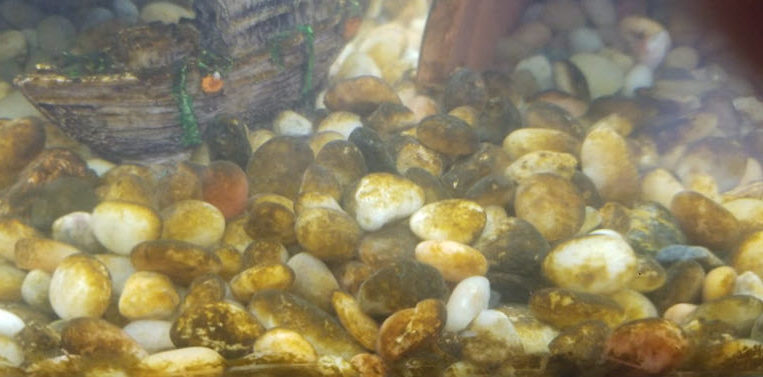
Initially “brown algae” is poor in nutrients and most fish typically won’t eat it. But after a few months it becomes much more nutritious and fish will eat it. So if one cleans the algae away constantly it never matures and most fish never start eating it (snails and plecos are an exception). So cleaning the algae actually just makes the problem worse!
There will ALWAYS be some brown algae in any aquarium. Personally I’ve learned to decorate in such a way that the brown algae is just part of the “natural” look in the aquarium. A little brown on brown sandstone rocks, driftwood and green plants is quite natural and acceptable. If one wants to decorate with white buddhas and pink plants, one will have huge problems keeping brown algae at bay. The following “pink” aquarium will have HUGE problems with brown algae:
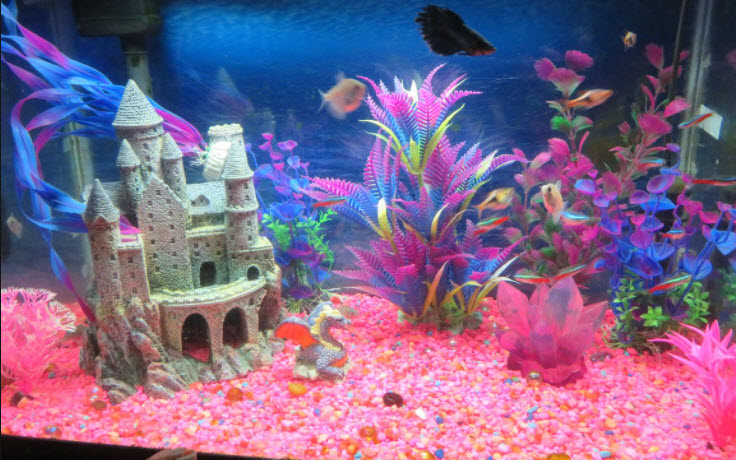
On the other hand the following “natural” decorating scheme allows brown algae to fit in without much of a problem:
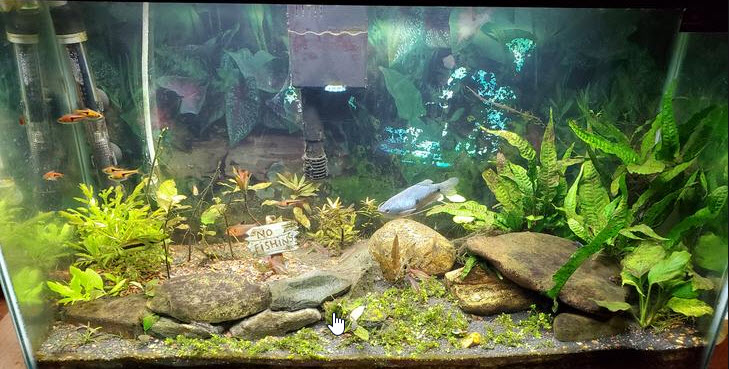
The Science of “Brown Algae”
In the hobby a brown film in the aquarium is commonly called “brown algae” or “diatoms”. The term “brown algae” is somewhat of a misnomer. If you examine most “brown algae” under a microscope you will find it is very roughly about 50% porous detritus and organic “slime” (thus the “slimy” feel) and 50% a mixture of diatoms, other algae, cyanobacteria, bacteria, water molds, flagellates, ciliates and many other microscopic critters.
The exact mix is highly variable and dependent on things like light and nutrients. For instance, with moderate light (especially blue light) and high silicate in the water, diatoms will predominate, but with low silicate and high phosphates red algae might predominate. Where there is little light bacteria will predominate. It happens on all surfaces in virtually all aquariums and is just part of Mother Nature. It will appear even with no light.

As a “brown algae” film ages over the span of several months it will typically go from a nutrient poor diatom brown algae (Chrysophyta) film to a nutrient rich green algae (Chlorophyta) film. Then it may slowly build up a very tenacious red algae growth (Rhodophyta).
In a filter which has been established for two or three months there will be a brown film on all the surfaces. This brown film is beneficial bacteria. But it is identical in appearance to “brown algae”. And it forms with no light at all.
This “brown algae” typically grows rampant for the first few months of an aquarium’s existence. Initially the brown film consists of only relatively nutrient poor species (diatoms are very nutrient poor) which fish won’t “graze”. As the film matures it develops a more nutrient-rich species profile (“periphyton”) and many fish will graze on it and control it to some degree. Thus, it is common for a “brown algae” problem to become less with time in the aquarium.

Diatom Control via Lighting
Diatoms are Chrysophyta algae. Chrysophyta have both reddish carotenoid pigments and green chlorophyll in them so they are brownish green. Both types of pigments harvest light for energy. Chrysophyta carotenoids absorb blue light and photosynthesize with it. So only blue light will give an outbreak of brown algae. NICREW ClassicLED Aquarium Lights and some other light designed for reef aquariums have only blue light and white LEDs and can be a problem when it comes to diatoms.
Most aquarium lights have blue and crimson LEDs in addition to largely white LEDs. Blue and red will grow green plants well with less brown algae.
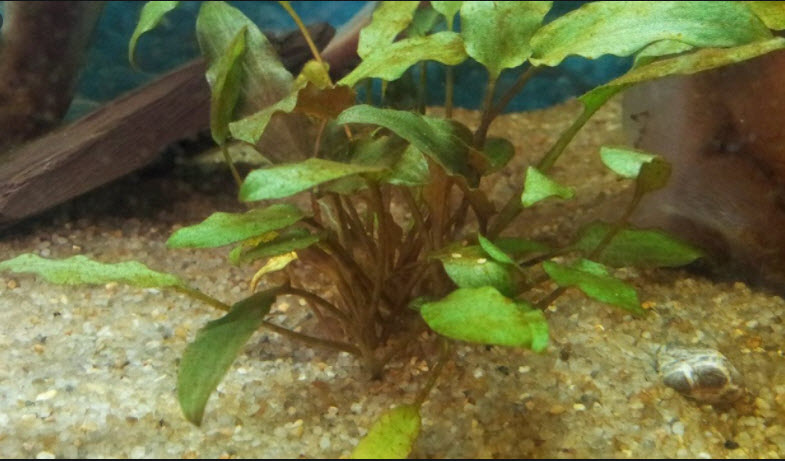
Controlling Brown Algae
Stopping brown algae films from forming on aquarium decorations requires bleaching them every few weeks. And of course bleaching requires scrupulous attention to neutralizing the bleach before putting the decorations back into the aquarium. This is done by soaking in strong water conditioner for several hours after bleaching.
If you want to do huge amounts of work and cleaning, you can take on the task of keeping aquarium substrate and decorations clean of brown algae. Most just don’t have the time to do that. So most hobbyists just accept some brown film on most of the surfaces in an aquarium. I only clean the brown algae off of the front and side glass every few weeks and I leave it on the back glass and rocks.
Nerite snails and suckermouth fish can also control brown algae to some degree. And a properly planted aquarium will have little to moderate brown algae after it becomes settled (typically six months or more).

Myths
Like all things in the aquarium hobby there are some myths about brown algae and diatoms:
- Diatoms are a bacteria
- Quartz sand leaches silica which encourages diatoms to grow
Diatoms are a form of “brown algae” or Chrysophyta. Chrysophyta include such diverse plants as kelp and diatoms and are responsible for about 50% of the photosynthesis in the world and thus easily 50% of life on earth. Diatoms most decidedly are NOT bacteria.
Brown algae outbreaks are often claimed to be related to the silica in the water, since diatoms need silica to form their shells. This is an academic discussion of no importance since there is no way to remove silica from the water (contrary to some manufacturers claims). So every water change will bring about the addition of silica to the aquarium.
Silica categorically cannot leach out of your substrate. Silicates such as quartz are completely and totally insoluble at the temperatures and pressures in an aquarium. Very tiny amounts of silicate will dissolve from quartz ONLY at very high pressures (like 10,000 psi) and high temperatures (like 1,000 degrees F.) . In any case a diatom free brown biofilm will develop in an aquarium which has no silica in it.
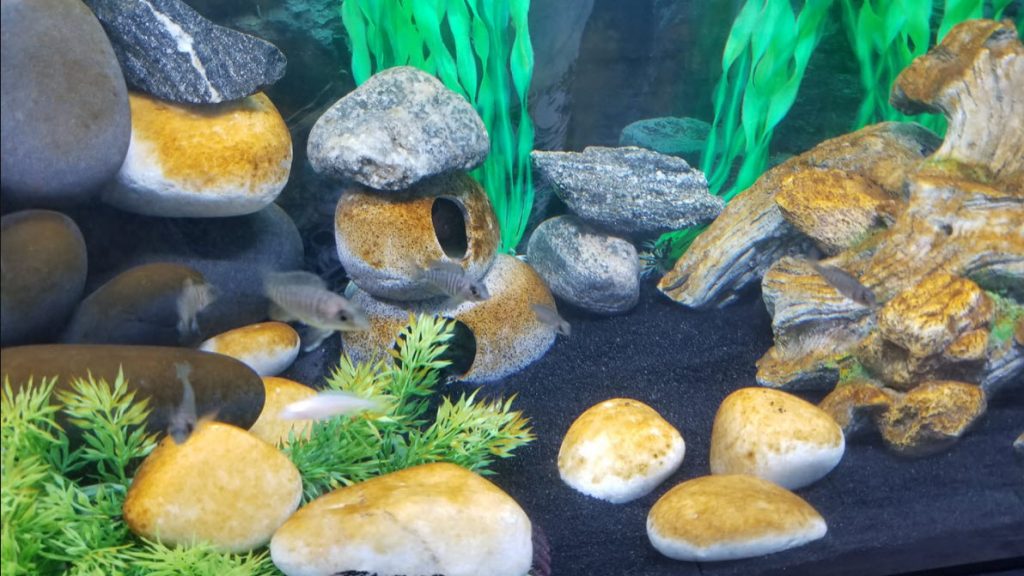
Here is a link to an article on controlling all types of algae:
16.2. Controlling Algae
.
Return to Algae Menu
.
Aquarium Science Website
The chapters shown below or on the right side in maroon lead to close to 400 articles on all aspects of keeping a freshwater aquarium. These articles have NO links to profit making sites and are thus unbiased in their recommendations, unlike all the for-profit sites you will find with Google. Bookmark and browse!
.
